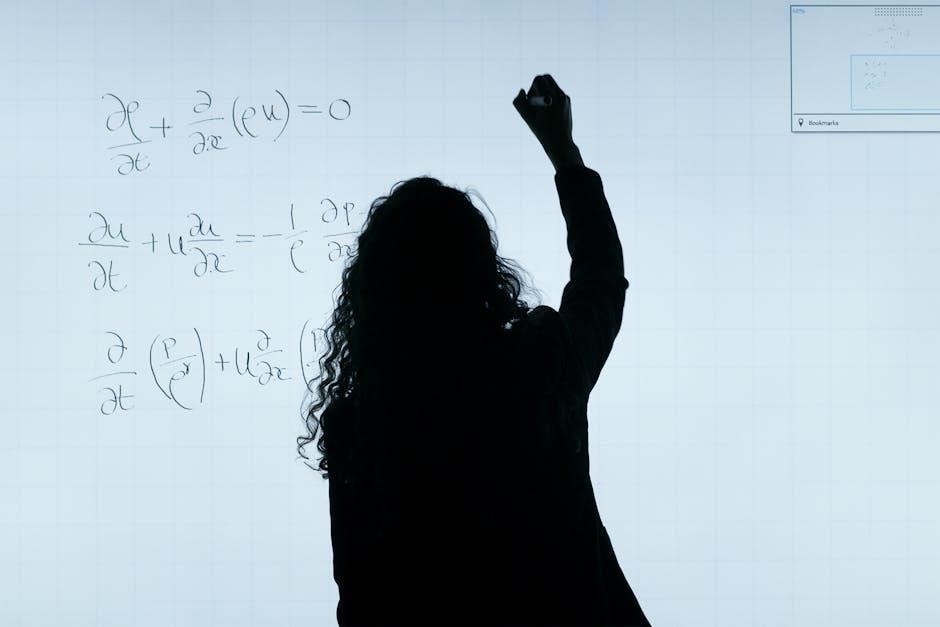Welcome to the world of AP Physics! This course introduces foundational concepts like mechanics, energy, and motion. It blends theoretical knowledge with practical applications, fostering critical thinking and problem-solving skills. Understanding physics principles is key to excelling, as memorization alone won’t suffice. Prepare to explore the fascinating science behind everyday phenomena and build a strong foundation for advanced studies.

Overview of the AP Physics 1 Exam
The AP Physics 1 exam is a college-level, algebra-based assessment that evaluates understanding of foundational physics concepts. It covers topics such as kinematics, dynamics, energy, and momentum, emphasizing scientific inquiry and critical thinking. The exam consists of two sections: a 50-minute multiple-choice portion with 55 questions and a 90-minute free-response section with 5 problems. Together, these sections test problem-solving skills, conceptual knowledge, and the ability to apply physics principles to real-world scenarios. The exam is scored on a scale of 1 to 5, with a score of 3 or higher often qualifying for college credit. To succeed, students must focus on understanding underlying concepts rather than memorizing formulas. Effective preparation involves practicing both calculation-based problems and verbal explanations. The exam is designed to challenge students to think deeply and apply physics to a variety of situations, making it a rigorous yet rewarding experience.
Importance of Understanding Concepts Over Memorization
Mastering AP Physics 1 requires a deep understanding of core concepts rather than mere memorization. While formulas are useful, comprehending the principles behind them is crucial for solving complex problems and explaining phenomena. The exam emphasizes application and analysis, testing the ability to connect ideas across topics. Memorization often leads to superficial knowledge, which can fail under pressure. In contrast, conceptual understanding provides a flexible framework for tackling diverse scenarios. Students should focus on why formulas work, how forces interact, and how energy transforms. This approach builds problem-solving skills and confidence. By prioritizing understanding, students can adapt to novel situations and excel in both the exam and future scientific endeavors. This mindset is essential for success in AP Physics 1 and beyond.

Exam Format and Content
The AP Physics 1 exam is algebra-based, focusing on mechanics, energy, and motion. It includes multiple-choice and free-response sections, testing conceptual understanding, analytical skills, and problem-solving abilities effectively.
Multiple-Choice Section Strategies
The multiple-choice section of the AP Physics 1 exam tests your ability to apply concepts to specific scenarios. To excel, focus on understanding the question thoroughly before selecting an answer. Skim through all questions first to gauge their difficulty and prioritize easier ones. Identify key terms in the stem and use the process of elimination to narrow down choices. Avoid spending too much time on a single question—make an educated guess if necessary. Budget your time wisely, allocating about 1-2 minutes per question. Practice recognizing common distractors and focus on the underlying physics principles rather than memorized formulas. Finally, review your answers if time permits, ensuring you’ve selected the best possible choice based on your understanding.
Free-Response Section Tips
The free-response section of the AP Physics 1 exam requires clear, concise explanations of concepts and problem-solving processes. Begin by carefully reading each question to understand what is being asked. Always show your work, as partial credit is awarded for correct steps. Use proper scientific notation and units where applicable. When presenting equations, derive them logically or reference the principles they represent. Organize your answers in a structured manner, addressing each part of the question separately. Avoid unnecessary jargon or overly complicated explanations. Practice writing complete sentences and ensuring your reasoning is evident. Time management is critical—allocate approximately 15-20 minutes per question. Review your responses briefly before submitting to correct any errors or clarify ambiguous points. Demonstrating a deep understanding of physics principles will significantly improve your score in this section.

Core Topics and Key Concepts
Mastering kinematics, dynamics, work-energy, momentum, and rotational motion is essential. These topics form the backbone of AP Physics 1, requiring a deep understanding of principles and their applications.

Kinematics: Motion Along a Line and in Two Dimensions
Kinematics is the study of motion without considering forces, focusing on position, velocity, and acceleration. In AP Physics 1, you’ll explore motion in one dimension and extend it to two dimensions. Key concepts include graphical analysis of motion, such as velocity-time and position-time graphs, which help visualize acceleration and displacement. Understanding how to derive equations of motion, like the constant acceleration formulas, is crucial. Additionally, motion in two dimensions involves breaking vectors into components, analyzing projectile motion, and understanding circular motion. Mastery of kinematics requires problem-solving skills, as you’ll often need to interpret and apply these concepts to real-world scenarios. Practice interpreting graphs, solving vector problems, and applying kinematic equations to build a strong foundation for more complex topics like dynamics and energy.
Dynamics: Forces and Newton’s Laws
Dynamics explores how forces influence motion, governed by Newton’s three laws. The first law explains inertia, while the second relates force, mass, and acceleration (F=ma). The third law describes action-reaction pairs. Understanding these laws is vital for analyzing forces in various systems. Key topics include friction, tension, and normal forces, often requiring free-body diagrams to visualize and solve problems. You’ll also study how forces change motion over time, using graphical methods to interpret force vs. time graphs. Mastery of dynamics involves applying these principles to real-world scenarios, such as inclined planes, pulley systems, and collision problems. Practice drawing force diagrams and solving vector-based problems to strengthen your understanding. This foundation is essential for advanced topics like momentum and energy, making dynamics a cornerstone of AP Physics 1.
Work, Energy, and Power
Work, energy, and power are fundamental concepts in AP Physics 1, linking force and motion. Work is defined as force applied over a distance, leading to energy transfer. The work-energy theorem states that work done on an object changes its kinetic energy. Energy comes in forms like kinetic (motion), potential (stored), and thermal. Conservation of energy is a key principle, emphasizing that energy changes forms but isn’t created or destroyed. Power, the rate of energy transfer, is calculated as work divided by time. Mastering these concepts requires solving problems involving calculations of work, energy transformations, and power. Focus on understanding the relationships between these quantities and their real-world applications, such as calculating the work done by forces or the power output of a system. Practice with graphical interpretations and scenario-based problems to solidify your grasp of these essential dynamics.
Momentum and Collisions
Momentum, a vector quantity defined as mass times velocity, is central to understanding collisions. Conservation of momentum is a key principle, stating that in a closed system, total momentum remains constant. Collisions can be elastic (kinetic energy conserved) or inelastic (some energy lost). Perfectly inelastic collisions result in objects moving together post-collision. Calculating momentum transfer and distinguishing between collision types is crucial. Practice solving problems involving conservation of momentum and energy transformations to master this topic. Common mistakes include misapplying conservation laws and not accounting for vector directions. Focus on clear diagramming and systematic approaches to avoid errors and enhance problem-solving efficiency.
Rotational Motion
Rotational motion involves objects moving in circular paths, with concepts like torque, angular acceleration, and rotational inertia essential to understanding. Torque, a force that causes rotation, is calculated as τ = r × F. Angular acceleration (α) relates to torque and rotational inertia (I) via τ = Iα. Rotational inertia depends on mass distribution relative to the axis. Key formulas include KE_rot = ½ Iω² for rotational kinetic energy and L = Iω for angular momentum. Conservation of angular momentum is crucial in closed systems. Practice problems involving rolling without slipping and equilibrium conditions. Common errors include neglecting to square the radius in inertia calculations. Focus on visualizing rotations and applying the right analogs to linear motion, like torque to force. Mastering rotational dynamics enhances problem-solving in diverse scenarios, from simple gears to complex systems. Ensure diagrams and axis choices are clear to avoid confusion.

Problem-Solving Strategies
Start by understanding the problem, listing knowns, and sketching diagrams. Identify key concepts and relationships; Check units and dimensions to ensure consistency. Practice applying formulas logically. Verify each step for accuracy and clarity.
Identifying Key Variables and Drawing Diagrams
Identifying key variables and drawing diagrams are essential problem-solving skills in AP Physics. Start by carefully reading the problem to extract knowns and unknowns. Label quantities with proper units and symbols. Sketching a diagram helps visualize the situation, whether it’s motion along a line or forces acting on an object. For kinematics, plot position-time or velocity-time graphs. In dynamics, free-body diagrams are crucial for analyzing forces. Always check that units are consistent and dimensions are correct. Practice identifying variables systematically to avoid missing critical information. Diagrams not only organize your thoughts but also reveal relationships between quantities. Over time, this structured approach will enhance your ability to tackle complex problems efficiently and accurately. Consistent practice will make this process second nature, improving your overall performance in physics.
Applying Formulas and Derivations

Mastering the application of formulas and derivations is a cornerstone of success in AP Physics. It’s crucial to understand the underlying principles rather than memorizing equations. Start by deriving formulas from fundamental concepts to grasp their meaning and limitations. For example, kinematic equations can be derived from basic definitions of motion. When applying formulas, always ensure units are consistent and dimensional analysis is correct. Practice substituting known values and checking if the results make sense physically. Common formulas, like Newton’s second law (F = ma) or the work-energy theorem (W = ΔKE), should be applied thoughtfully. Derivations also help in understanding how different quantities relate, such as torque and angular acceleration. Regular practice will build fluency in applying these tools to solve complex problems efficiently and accurately.

Practice Exams and Resources
Utilize official practice exams to simulate test conditions and identify weaknesses. Explore free study guides from Marco Learning and UWorld for targeted practice. YouTube channels like Nerd-Notes offer video explanations to clarify complex topics, while online resources provide interactive simulations and problem sets to reinforce learning. Regular practice with diverse materials enhances problem-solving skills and builds confidence for exam day.
Using Official Practice Exams Effectively
Official practice exams are invaluable for AP Physics 1 preparation. They simulate real test conditions, helping you manage time and reduce exam-day anxiety. Take timed sections to build stamina and focus. Review your answers thoroughly, identifying weaknesses and understanding mistakes. Use these insights to target specific areas in your studies. Regular practice exams track progress and reinforce problem-solving strategies. Combine them with study guides from Marco Learning and UWorld for a comprehensive review. Consistent use of official materials ensures familiarity with question formats and content emphasis, boosting confidence and readiness for the actual exam.
Recommended Online Resources and YouTube Channels
Supplement your AP Physics 1 studies with trusted online resources and YouTube channels. Marco Learning offers free study guides covering key topics, while UWorld provides interactive practice questions. For video tutorials, channels like 3Blue1Brown and NerdNotes explain complex concepts in an engaging manner. Physics Girl and Veritasium offer experimental demonstrations to deepen understanding. Additionally, websites like Khan Academy and College Board provide official study materials and practice exams. YouTube channels such as Physics Lessons by Eugene Khutoryansky and AP Physics 1 with Jason offer detailed lectures and problem-solving strategies. These resources complement your textbooks and classroom learning, ensuring a well-rounded preparation for the exam. Utilize these tools to reinforce concepts, visualize physics principles, and practice problem-solving effectively.

Study Tips and Exam Preparation

Effective studying involves creating a schedule, practicing regularly, and reviewing notes. Avoid common mistakes, manage exam time wisely, and stay confident. Consistent effort leads to success.
Creating a Study Schedule
A well-organized study schedule is essential for mastering AP Physics 1. Start by breaking down the syllabus into manageable sections, focusing on key topics like kinematics, dynamics, and energy. Allocate specific time slots for each subject, prioritizing areas where you need improvement. Set daily and weekly goals to ensure steady progress. Incorporate regular problem-solving sessions, as applying concepts is crucial. Dedicate time for reviewing notes, watching video explanations, and practicing past exam questions. Schedule breaks to avoid burnout and maintain focus. Consistency is key—stick to your plan but remain flexible to adapt as needed. Regular review sessions will help reinforce learning and build confidence for the exam. By staying organized and committed, you’ll be well-prepared to tackle the challenges of AP Physics 1.
Common Mistakes to Avoid
When preparing for the AP Physics 1 exam, there are several common mistakes to avoid. One of the most frequent errors is relying too heavily on memorization without understanding the underlying concepts. Physics requires a deep grasp of principles, not just rote learning. Another mistake is neglecting to practice free-response questions, which test your ability to explain and apply concepts. Many students also underestimate the importance of unit analysis and dimensional consistency, leading to incorrect answers. Additionally, failing to draw diagrams or identify key variables before solving problems can result in wasted time and errors. Avoid procrastination and ensure consistent study habits. Lastly, don’t overlook seeking help when struggling with a concept—persistent misunderstandings can widen knowledge gaps. By addressing these mistakes proactively, you can improve your performance and confidence on exam day.
Final Exam Strategies
On exam day, employ effective strategies to maximize your performance. Start by carefully reading each question and identifying key terms. For the multiple-choice section, eliminate incorrect answers first to increase your chances of selecting the right one. Time management is crucial—allocate equal time to each question and avoid spending too long on a single problem. For free-response questions, clearly explain your reasoning and show all work, as partial credit is awarded. Maintain a calm and focused mindset; stress can hinder your ability to think clearly. Review formulas and concepts mentally before starting, but avoid cramming. Use the provided equations sheet wisely, but don’t rely on it exclusively. Finally, ensure you’re well-rested and mentally prepared. By staying organized, methodical, and confident, you’ll be well-equipped to tackle the AP Physics 1 exam effectively.



